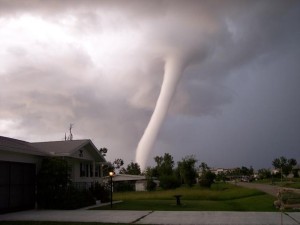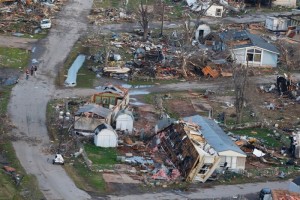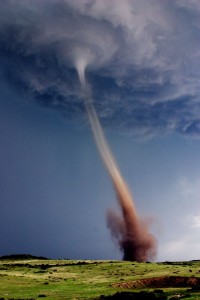How to Prepare for a Tornado!
How to Prepare for a Tornado
 A tornado can appear as a funnel shape, spinning through the air or may just appear as a dark cloud on the horizon. Tornadoes develop out of strong thunderstorms and can be devastating and even fatal. Rotating winds can get up to 300 mph and tornadoes path of damage can be more than a mile in width and as much as 50 miles in length.
A tornado can appear as a funnel shape, spinning through the air or may just appear as a dark cloud on the horizon. Tornadoes develop out of strong thunderstorms and can be devastating and even fatal. Rotating winds can get up to 300 mph and tornadoes path of damage can be more than a mile in width and as much as 50 miles in length.
 There is risk of a tornado at some level just about anywhere. Some tornado’s are easily seen; others may be hidden by blinding rain or low clouds. Tornadoes are known to crop up very quickly with little or no warning ahead of time. Early warning and preparation are big ways to reduce injury and fatalities.
There is risk of a tornado at some level just about anywhere. Some tornado’s are easily seen; others may be hidden by blinding rain or low clouds. Tornadoes are known to crop up very quickly with little or no warning ahead of time. Early warning and preparation are big ways to reduce injury and fatalities.
Typically, before a tornado is about to hit, it’s suddenly very still and quiet. Sometimes you will see a swarm of debris in the air even without a visible funnel cloud. Since tornadoes usually happen along the edge of a thunderstorm, don’t be fooled by the fact that there may be sunny and clear skies beyond the tornado cloud.
Facts You Should Know About Tornadoes:
 Average forward moving speed is from 30 mph; can be from zero movement to 70 mph.
Average forward moving speed is from 30 mph; can be from zero movement to 70 mph.- Tornadoes over water are called waterspouts
- Peak season in northernmost states is end of spring and beginning of summer months
- March to May is tornado season for south states.
- Most often sighted in spring and summer seasons east of the Rocky Mountains.
- Can move any direction but typically move southwest to northeast.
- May touch down out of nowhere with little advance notice.
- Hard to see when they first form until they suck up debris and dirt or a funnel cloud forms.
How to be Prepared for a Tornado
- Start paying more attention to weather conditions and patterns in your area so you will notice when things are not normal.
- Create a plan with family members for how you will communicate when a tornado, is moving in.
- Put together an emergency kit similar to the one found here. Include 72 hrs. of water and food and a NOAA emergency radio with multi-charging options including hand crank.
- Know tornado terminology. Most important to know is the difference between a tornado watch (conditions are right for a tornado) and a tornado warning (a tornado has been sighted in your area). Also understand that a tornado emergency means a tornado was seen moving toward fully populated location, and a severe thunderstorm warning means a significant thunderstorm has been seen, tornadoes are possible.
- Watch for the Following Danger Signs. Dark skies, a green tint to the sky could mean hail, an orange or rusty sky could mean dirt blown by high winds, seeing large-sized hail, dark spinning clouds low to the ground, a thunderstorm followed by extreme quiet and stillness, debris floating near the ground, Freight train or jet sound or very loud roar, white or blue-green flashes off in the distance but near the ground could be power lines snapping.
How to Safely Seek Shelter
- Mobile homes or manufactured offices are dangerous places and are often in adequately anchored and will be least likely to withstand the strong, sustained winds of a tornado.
- Best Action: Leave and find the nearest storm shelter or go to the ground floor of a more secure building.
- A somewhat sturdy structure such as house, school, small building, or store, etc.
Best Action: Follow tornado drill instructions or signs to the nearest pre-determined safe room. This may be a basement area or room on the ground floor, or even a storm shelter if available.
- In a high-rise apartment or office building.
Best Action: Locate a hallway, closet or small room without an outside wall. Secure any furniture or mirrors that could hit you.
- Outside without a sturdy building nearby. This is probably the worst case scenario and unfortunately there is no best action because in this last minute situation there are so many variables that can impact your safety.
Suggested Actions:
Try to take cover in a vehicle if one is available. Wear the seat belt and attempt to drive to the nearest shelter unless you are hit by debris. As an alternative, you can seek shelter in a parked vehicle with the seat belt on and your head covered with your arms and some other cushioning such as a blanket or cushion.
Lie down in a ditch or other place that is lower than the surface of the road. If you can, bring a blanket or coat so you can cover your head with it and your arms to protect from debris and glass.
How to Deal with Tornado Aftermath
- Stay on your Toes. Wait out the storm, make sure it has passed. Confirm via your emergency radio that the danger for your area has passed.
- Medical Assistance is a priority. Use your first-aid kit to care for your injuries and those around you as best you can. Once storm is over, seek additional help if needed.
- Inspect for Damage. Turn off the water, gas, and electric coming into the building. Check your home or office for any damage using a flashlight if needed. Look for damage that could mean the building is still unsafe. If you find structural damage, gather supplies and seek other shelter.
- Help Others. If you made it through without injury or property damage, count your blessings. Work with public officials to find out how you can best help others recover.
- Clean Up Safely. If the storm is over, begin cleaning up what you can. Wear gloves if you have them. Take photos of damage for your insurance company. Move hazardous items carefully.
Tornados can be scary and can wreak havoc in a matter of minutes. There will be no time to learn how to stay safe once one is on the way. Prepare now so you know how to seek shelter, stay safe, and deal with the aftermath of a tornado.
Aftermath How to Prepare for a Tornado Preparation prepare Shelter tornado Tornadoes

